The moon serves as a natural satellite revolving around our planet. Its significance is so profound that scientists frequently refer to the “Earth-Moon” system not merely as a planet and its satellite, but as a dual planet. The moon’s origin remains a subject of ongoing discussion. Let’s delve into the various theories surrounding its formation.
What exactly is this peculiar “planet”?
The moon has a profound impact on various aspects of life on Earth, and this influence has been evident throughout human civilization. Even ancient hunters who pursued mammoths relied on the moon’s phases to mark the passing of days. For early civilizations, the Earth’s satellite held immense significance as a deity that controlled the agricultural cycle. Many ancient civilizations worshipped the moon as a powerful goddess, constructing temples and even making sacrifices, at times including human ones. Lunar eclipses were particularly feared, as they were seen as a sign of divine anger and impending calamities. During the Middle Ages, the moon was believed to be inhabited by angels, while the Enlightenment brought about theories of a race of Selenites living on the nocturnal luminary. However, scientific progress soon shattered these naive beliefs, revealing the moon to be a lifeless and unappealing celestial body from a human perspective. Nonetheless, it became apparent that our satellite exerts a significant influence on Earth’s processes. Without the moon, it is likely that Earth would lack a biosphere and resemble planets like Mars or Venus. This is because the presence of the moon determines a crucial climatic parameter – the tilt of Earth’s axis of rotation in relation to the plane of its orbit, which in turn dictates the changing seasons.
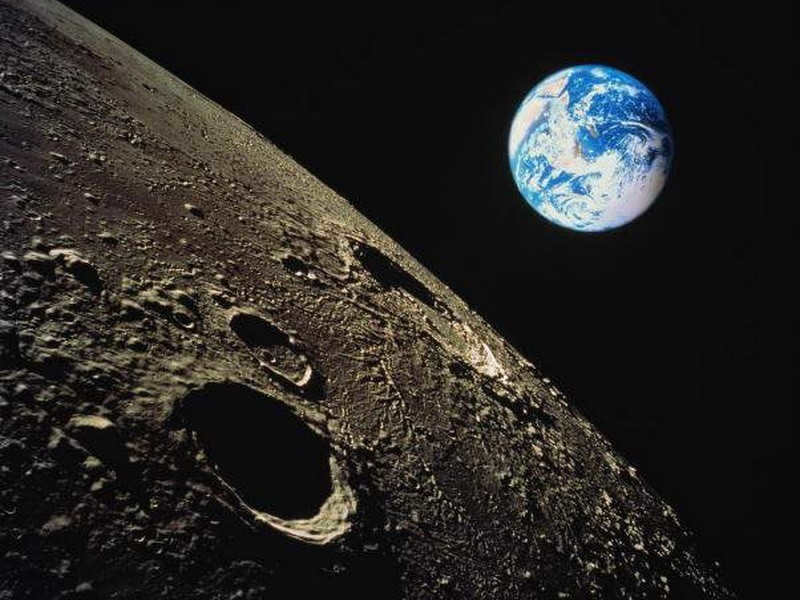
Benefits of the Moon for Earth
The stability of Earth’s rotation and climate is largely attributed to the presence of the Moon, according to the majority of scientists. Without the Moon, there would be a risk of chaotic fluctuations in the angle of inclination, which could have devastating effects on Earth’s climate. The absence of a large satellite would create conditions for extreme variations in the angle between the equator and the orbit, making the planet’s climate unsuitable for habitation.
The positive influence of the Moon did not end there, as it played a crucial part in the development of life by creating tides that oxygenated the oceans. It is even possible that life first originated in the tidal zone! Furthermore, the Moon’s movement across the sky has a significant impact on the life cycles of numerous organisms. An interesting illustration of this is observed in swordtails, which are marine arthropods distantly related to crayfish and crabs. These creatures only reproduce when the Moon is in a specific phase.
Subsequent observations of the Moon played a significant role in the advancement of planetary science – as no other celestial body (aside from our own planet) has been studied in such meticulous detail! However, as our understanding of the Moon grew, numerous perplexing questions emerged. The most baffling enigma was the Moon’s origin – various hypotheses were proposed, yet none of them could fully account for all the available evidence. What are the primary characteristics of our satellite that have posed such challenges for scientists?
Let’s outline the key ones:
- The Moon’s average density is significantly lower than that of the Earth, primarily due to its diminutive core (whereas the Earth’s core constitutes roughly 30% of the planet’s mass, the Moon’s core constitutes no more than 2-3%);
- The Moon exhibits a higher concentration of heavy elements (such as thorium, uranium, and titanium);
- The ratio of oxygen isotopes in the Earth’s and Moon’s crust is practically identical, although it varies significantly among planets and meteorites from different parts of the Solar System.
- The lunar crust is considerably thicker than that of the Earth, suggesting that all of its constituent matter was once in a molten state. In contrast, it is believed that the Earth has never been completely molten.
- Furthermore, the Moon’s orbit plane does not align with the Earth’s equatorial plane.
Among the numerous hypotheses regarding the origin of our satellite, three theories have gained the most popularity among scientists. Let us elaborate on them.
Hypotheses regarding the Moon’s origin
One hypothesis suggests that the Moon was originally a separate small planet within the solar system, orbiting the Sun. However, at a certain point, the independent Moon approached the Earth too closely, and its gravitational force caused it to be captured and shifted into a new orbit, ultimately becoming a satellite revolving around our planet.
Unfortunately, the calculations have demonstrated that this hypothesis is unable to account for the unique characteristics of the lunar orbit. Additionally, the resemblance between elements found in both the Earth and lunar crust, discovered after the Moon landings, has cast doubt on the “capture” theory. Another widely accepted hypothesis, proposed by the esteemed Immanuel Kant, suggests that the Earth and Moon were formed together. According to this hypothesis, they both emerged from a single gas-dust cloud. As the proto-Earth accumulated mass, particles within the cloud began to orbit around it, gradually forming the proto-Moon.
Although the similarity in isotopes between the Earth and Moon partially supports this hypothesis, it does not provide an explanation for the unique characteristics of the lunar orbit.
After conducting an extensive analysis of lunar rock samples collected by the Apollo expeditions in the 1970s, researchers from the University of Washington have come to a different conclusion regarding the impact hypothesis. According to them, if the previous theory was correct, more than 50% of the lunar rocks would be made up of material from a planetoid that collided with Earth. However, the isotopic composition of the moon fragments tells a different story. The presence of heavy isotopes of potassium suggests that these rocks could have only formed under extremely high temperatures. This leads the researchers to believe that a massive collision, powerful enough to vaporize both a planetoid and a significant portion of Earth, is the only explanation for this unique isotopic composition.
As a consequence, researchers have proposed a fresh theory: rather than a massive collision of planets, there were numerous collisions with smaller asteroids. The continuous bombardment of asteroids “hurled” enough debris into Earth’s orbit, resulting in the formation of multiple small satellites that eventually merged into one large satellite. This entity, known as “Protoluna,” continued to capture objects in its orbit until it remained proudly solitary.
The authors of the study argue that their hypothesis is the most suitable explanation based on the available data. However, skeptics promptly emerged, pointing out that the new moon hypothesis fails to account for all the peculiarities of our nocturnal celestial body. Thus, the debate on the Moon’s origins remains inconclusive, as our Earth’s satellite continues to hold its enigmatic allure…
Ancient philosophers were captivated by the allure of the Moon well before modern astronomy emerged. Myths and legends were woven around its existence, and it was celebrated by storytellers of old. Presently, scientific knowledge has demystified the profound influence of this nocturnal celestial body on our world.
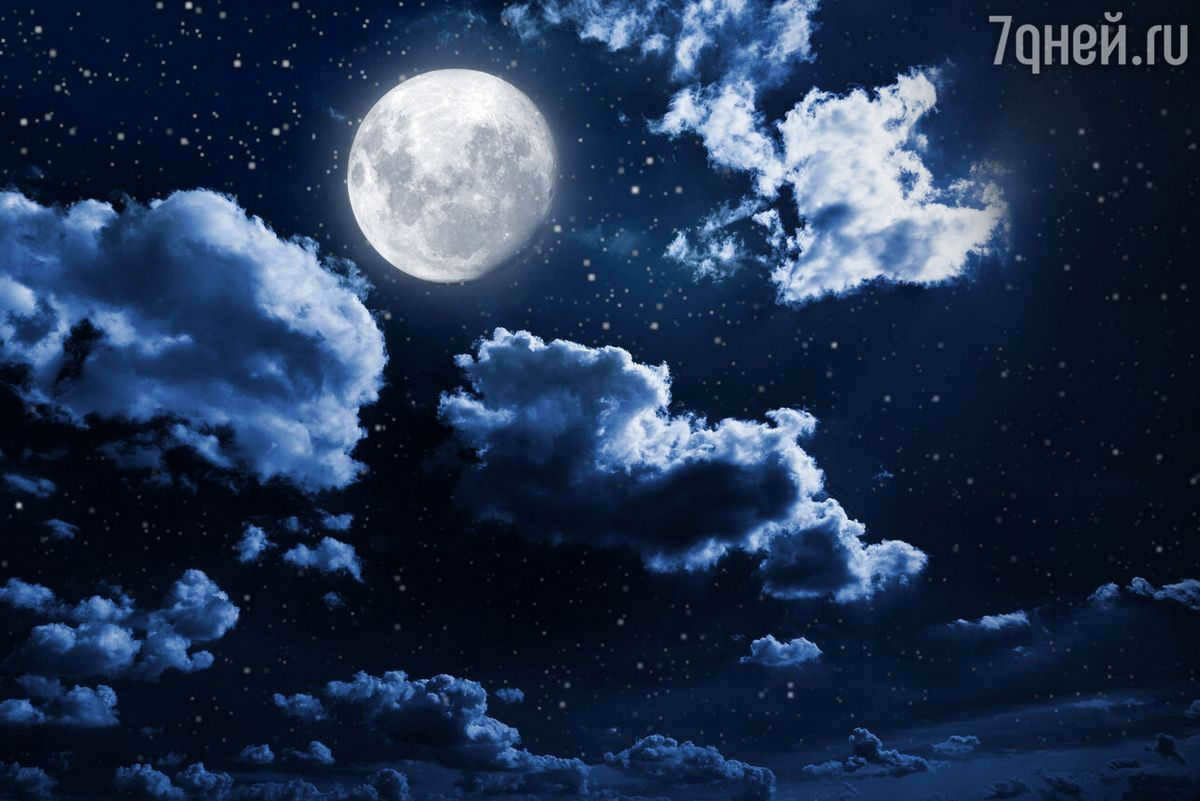
The Impact of the Moon on the Earth
The Earth has a natural satellite known as the Moon, which is positioned approximately 384,000 kilometers away. The Moon follows a slightly elliptical orbit, causing its distance from the Earth to vary at different times. It takes the Moon around 27.3 days to complete one revolution around the Earth. However, a full lunar cycle, from a full moon to a new full moon, lasts a little over 29.5 days. This difference leads to certain months where two full moons can be observed. So, how does the Moon influence the Earth and its inhabitants?
The lunar cycle, which lasts around 29.5 days, can be divided into six phases:
Moreover, the presence of the Moon in the celestial sphere exerts a decelerating effect on the rotational movement of our planet, causing a minuscule elongation of each Earth day by a microsecond. Without the Moon’s gravitational influence, the Earth’s rotation would intensify to such an extent that the diurnal period could potentially be reduced to a mere six hours, or possibly even less. This accelerated rotation would undoubtedly have profound consequences on the growth and evolution of flora and fauna, as well as precipitate a significant escalation in the velocity of atmospheric currents, thereby engendering a prevalence of tempests, twisters, and tropical cyclones.
The boundary between land and water
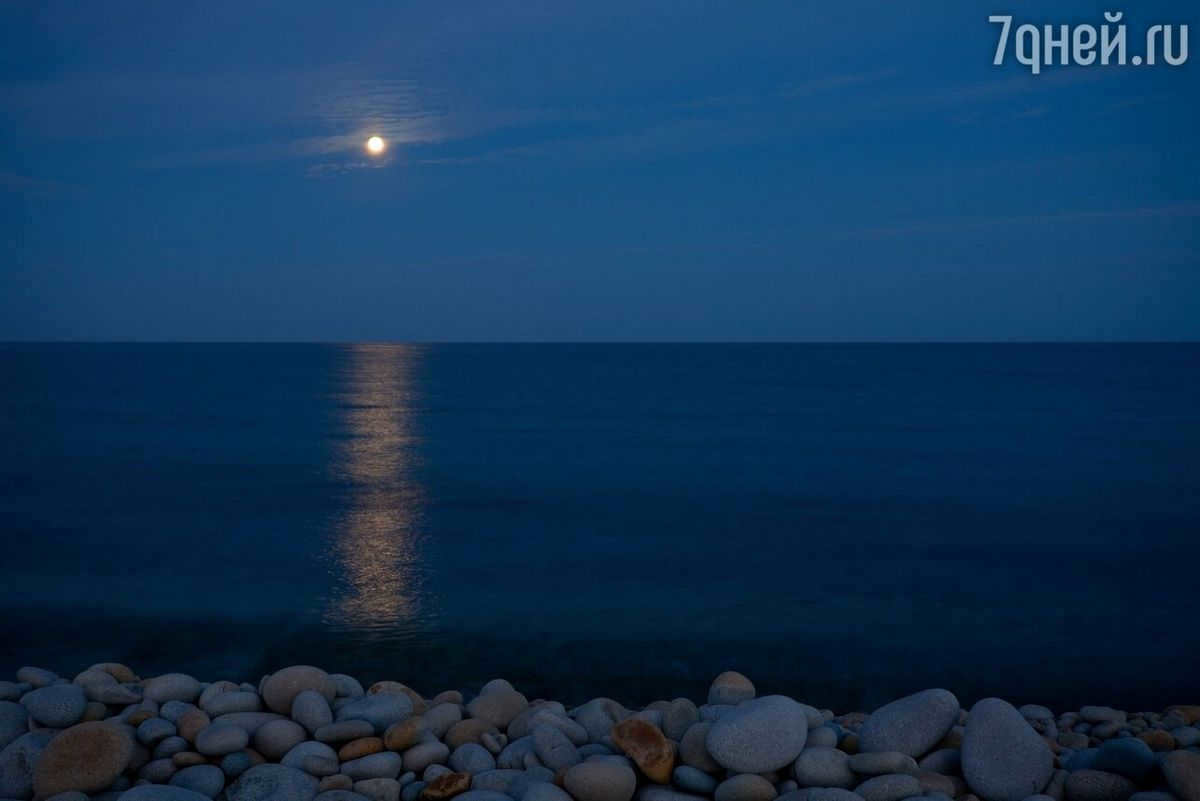
Since ancient times, people have been aware of the connection between the moon and the tides. Today, scientists have discovered that the gravitational pull of the moon causes the water in the ocean to be slightly stretched along its path. This results in the water moving behind the moon, creating oscillations. As the moon orbits around the Earth, it causes the familiar ebb and flow of the tides, which can vary in height by up to 15-18 meters.
The greatest tidal fluctuations and surges are found along the coastlines of the ocean. In our nation, these occur along the shores of the Arctic and Pacific Oceans. Inland seas, on the other hand, experience less significant tidal variations. Lakes and rivers, in comparison, observe even weaker tidal effects. However, even along ocean shores, the strength of the tides varies depending on the time of year. This variability is directly linked to the distance between the Moon and Earth. When the Moon is closer to our planet’s surface, the tides are more powerful. Conversely, when the Moon is farther away, the tides are weaker.
The “hidden” Sun
There are various natural occurrences that demonstrate the impact of the Moon on the Earth. One of the most remarkable of these is the solar eclipse. It is hard to fathom the intense emotions that this phenomenon evoked in ancient times. The eclipse was attributed to the demise or momentary vanishing of the celestial body due to malevolent gods. It was believed that unless specific ceremonial practices were performed, the light of the Sun might never grace their presence again.
Today, the phenomenon’s mechanism is thoroughly studied. The Moon, as it moves between the Earth and the Sun, obstructs the passage of light. This results in a portion of the planet being cast into shadow, allowing its inhabitants to witness a more or less complete eclipse. It’s intriguing to note that not all moons would possess this capability. In order for us to periodically witness a total eclipse, specific proportions must be met. If the Moon had a different diameter or if it were slightly further away, we would only be able to observe partial eclipses from Earth. Nevertheless, there is ample reason to believe that one of these scenarios will come to fruition in the distant future.
How the Moon impacts living organisms
There is evidence suggesting that the different phases of the Moon have an effect on bees, fish, certain birds, and amphibians. It is possible that the varying brightness of the Moon’s disk at night somehow regulates the production of melatonin, a brain hormone responsible for circadian rhythms (the daily cycle of activity). During a full moon, this hormone is produced more strongly, leading to changes in animal behavior.
Interestingly, many avid fishermen claim that the success of their catch is influenced by our celestial companion. This is not a mystical belief or folk myth, but a scientifically supported fact that has been confirmed numerous times in practice.
The lunar phase has a direct impact on the well-being of aquatic creatures, primarily because it has the ability to illuminate the Earth with sunlight reflected off its surface. During this time, a greater amount of light penetrates the water column, leading to a revitalization of the fish population. They become more active, excited, and move at a faster pace. This can be attributed to the fact that during a full moon, the Moon comes closest to the Earth, resulting in increased gravitational interaction. This gravitational pull is a significant factor in shaping fish behavior, and it also enhances the Moon’s luminosity.
Therefore, the optimal time for fishing would be during a full moon.
The Moon’s gravitational field also influences the Earth’s biosphere and leads to changes in the Earth’s magnetic field.
There is no consensus in the scientific community regarding this matter. Scientists are divided in their opinions, with each side presenting evidence to support their viewpoint. While much of the Moon’s impact on Earth has yet to be proven, certain factors, such as tides, are recognized by both camps.
The Moon’s gravitational field has an impact on Earth’s biosphere, including changes in the planet’s magnetic field. The Moon’s rhythm affects tides, air pressure, temperature fluctuations, wind patterns, the Earth’s magnetic field, and water levels. Furthermore, the influence of tides extends beyond water areas and also affects the Earth’s crust, although this goes unnoticed due to its density.
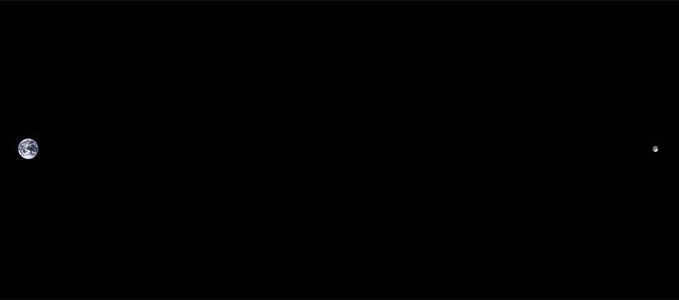
By the way, not only the Moon, but also the Sun has a tidal influence on the planet. However, the Sun’s influence is weaker due to its distance from the Earth. The height of solar tides is half the height of lunar tides. The phenomenon of lunar-solar tides plays a significant role in the Earth’s existence. It causes the Earth’s rotation to gradually slow down, leading to an increase in the duration of the day. The tidal force of the Earth is even stronger on the Moon, causing its rotation to become synchronized with its orbit around the Earth. As a result, the same side of the Moon always faces us. For instance, around 400 million years ago, a day on Earth was two hours shorter.
There is an intriguing theory regarding the Earth’s stabilization, which involves the satellite known as the Moon. In terms of size, the Moon is a relatively large satellite compared to the Earth. With a diameter of 3,474 km, it surpasses the Earth’s diameter of 12,742 km. According to planetologists, the Moon plays a crucial role in stabilizing the Earth’s orbit and the tilt of its rotational axis, thereby influencing the occurrence of seasons.
Over a period of two years, Indian physicians meticulously documented cases of heart attacks in correlation with the phases of the moon. Surprisingly, they discovered that heart attacks were 20% more prevalent during the new moon phase compared to the full moon phase. In contrast, a study conducted by German doctors failed to support the popular belief that wounds heal faster during the waning moon phase.
The menstrual cycle is not connected to the lunar calendar. Over a three-year period, American anthropologists observed the monthly cycles of women from an Indian tribe who lived in remote forests, far away from modern influences such as hormonal contraceptives and electric lighting. They found no evidence of a connection to the moon.
Similarly, the moon does not impact human behavior. Crime statistics do not show any correlation between the moon’s phases and the frequency or severity of criminal activity. However, psychiatrists from Liverpool argue that the moon does affect the mental state of individuals with schizophrenia.
It is common knowledge that the Moon is the nearest celestial object to Earth and the sole natural satellite of our planet. It has an impact on the cyclical nature of processes and the essential functioning of all living organisms on Earth, including humans (during both day and night). The most well-known manifestation of the Moon’s influence on Earth is its gravitational pull, which gives rise to the ebb and flow of tides in the seas and oceans. This gravitational force is most pronounced on the side of Earth facing the Moon, while the opposite side experiences no gravitational attraction. Consequently, the oceans are noticeably pulled in the direction of the Moon, resulting in tidal phenomena. Thus, the Moon exerts its natural influence on Earth without any artificial intervention, given that it is our planet’s only natural satellite.
If it were not for our satellite, the shape of the world’s oceans might be completely different. The gravitational interaction between the Earth and the Moon causes the water in the ocean to be slightly stretched along the Moon’s path. Without this interaction, the land would be struck by massive tsunamis with waves reaching heights of 50-60 meters. At such a large scale, the sea would engulf most of the land. Thankfully, the Moon’s presence prevents this catastrophe, but its orbit around the Earth creates the familiar ebb and flow of tides, which can vary by 15-18 meters.
A natural defense against threats from space
Influence on the length of a day
The interaction between the two celestial bodies has a direct impact on sleep, mood, and human behavior. For instance, during a full moon, a significant number of individuals, especially women, are more prone to experiencing insomnia and stress. It is a well-established fact that during this time, there is an increase in accidents, murders, and other crimes.
On the other hand, during a new moon, people tend to exhibit more aggression, moral exhaustion, and engage in impulsive actions. As the lunar phase increases, well-being begins to improve, and experts recommend initiating important tasks during this period.
Many dedicated fishermen claim that the effectiveness of their catch is influenced by our celestial companion. This is not a mystical belief or a mere folk myth, but a scientifically supported fact that has been confirmed numerous times through practical experience.
The lunar phase has a direct impact on the well-being of marine creatures, primarily because it has the ability to illuminate the Earth with sunlight reflected off its surface. As a result, the best time for fishing would be during the full moon. During this phase, the water receives the maximum amount of light, which stimulates the activity and excitement of fish, causing them to move more quickly. This can be attributed to the fact that during a full moon, the moon is closest to the Earth, resulting in increased gravitational interaction, which is a significant factor in fish behavior and also increases its brightness.
Light is essential for the survival of fish, and the most suitable form of light for them is moonlight. Without it, fish enter a period of drowsy rest, making it less than ideal to go fishing during the new moon.
The moon is not just a beautiful disk in the night sky, but a celestial body that plays a crucial role in the development of life as we know it today.

There is not a single individual on Earth who has not, at least once in their lifetime, gazed up at the night sky and marveled at the enchanting beauty of the moon. The moon captures the attention of every member of the human race. It even captivates those individuals who identify as staunch materialists. Even they, when they observe the moon, seek to witness something extraordinary and awe-inspiring.
The impact of the moon on human existence is not a mere myth or work of fiction, but a scientifically substantiated reality. How does this occur and what exactly is this impact? Let us delve deeper into this query and strive to ascertain the accurate answers.
What is the impact of the moon on human life and how does it occur?
It is important to acknowledge that the moon’s influence extends beyond individuals and encompasses the entire planet. As the Earth’s satellite, the moon orbits around our planet, reflecting sunlight off its surface. This gravitational force attracts vast amounts of water, giving rise to ocean tides.
Remarkably, the human body is composed mostly of water. Scientists affirm that the moon affects the human body in a similar manner to how it impacts the world’s oceans, causing tides within us. Consequently, our mood and well-being are influenced by the phase of the Earth’s primary satellite.
The lunar cycle can be categorized into five distinct phases:
What is the impact of the new moon on human life?
When the new moon occurs, it has a significant impact on our energy levels. The gravitational pull of the moon increases, causing a decrease in body mass. As a result, the fluid that was once concentrated in the head area is redistributed throughout the entire body. This shift can lead to heightened aggression in individuals with mental disorders. Common symptoms experienced during this time include:
- Increased aggression
- Nervousness
- Irritability
- Impatience
- Complaints of heart pains and headaches
Interestingly, the new moon’s effect appears to be more pronounced in men compared to women. Men may experience heightened nervousness, irritability, impatience, and may also complain of heart pains and headaches.
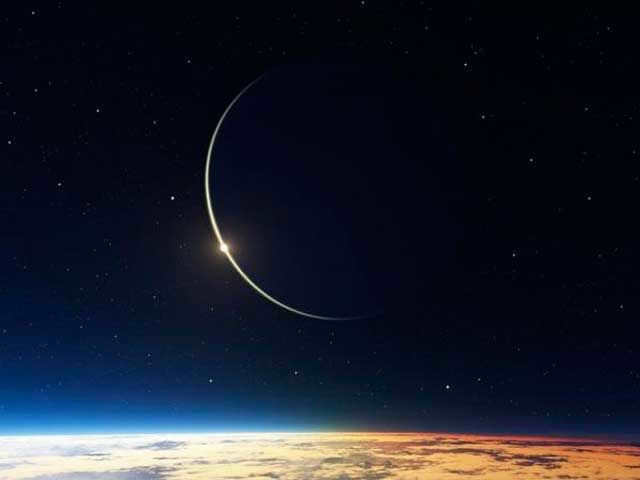
On the flip side, women will feel a sense of lethargy and fatigue. During this time, it is recommended to decrease physical activity. If you usually go to the gym, it is suggested to have a lighter workout during the new moon phase.
Detoxifying the entire body is an ideal activity for both men and women during this lunar phase. The skin is highly receptive to absorbing moisture, beneficial microelements, and more. Experts suggest taking warm baths, exfoliating the body and face, and limiting the consumption of heavy foods and alcoholic beverages.
From the day following the new moon until a week later, a remarkable transformation occurs in the moon as it gradually increases in size. Alongside this growth, the forces surrounding us also intensify. Consequently, our energy levels rise and our moods experience a noticeable improvement. It is within this specific time frame that any undertaking, no matter how wild or improbable, holds a significantly greater probability of achieving success compared to the new moon phase, second, third phase or full moon.
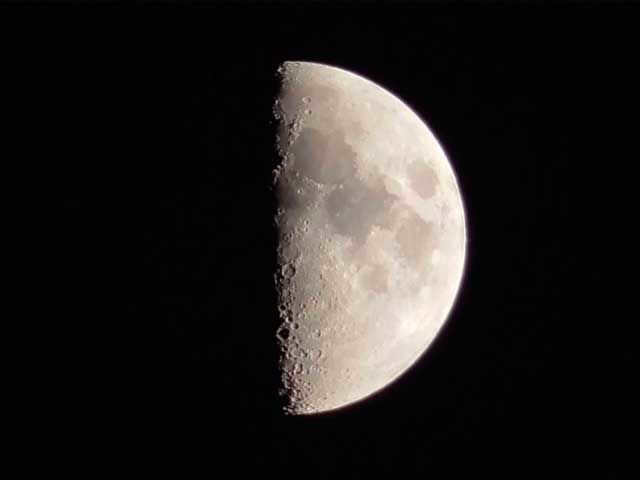
The first phase of the moon is beneficial for ingraining helpful habits into our subconscious mind. If you desire to adopt a new beneficial habit, it is advisable to commence now. In terms of physical activity, you can amplify its intensity. Currently, the moon encourages meditation and the mastery of different breathing techniques.
Effect of the Second Phase of the Moon on an Individual
The second phase of the moon commences on the eighth day following the new moon and concludes one week later with a full moon. This phase exerts a highly favorable influence on an individual’s well-being and overall existence, endowing them with an abundance of energy and positive emotions. Nevertheless, it is crucial to bear in mind that unutilized potential in the future may give rise to symptoms of depression, nervous breakdowns, excessive emotional sensitivity, or apathy. Thus, it is imperative to take action promptly rather than postpone one’s plans indefinitely!
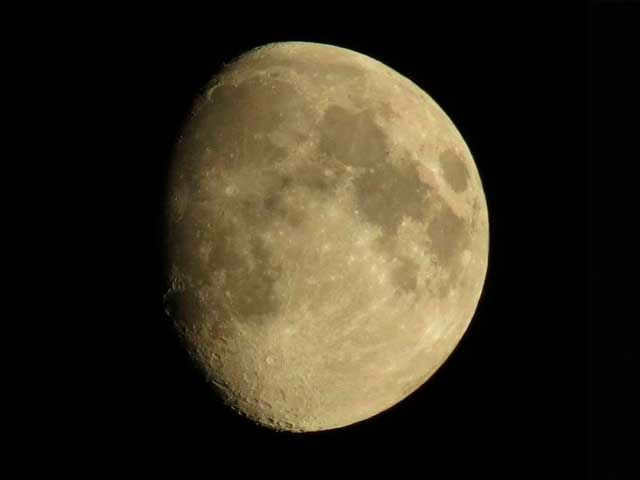
During the second stage, the body experiences a noticeable increase in metabolism. It is important to focus on the abdomen and chest areas.
This is the perfect time for intense and powerful training to make you feel your best! If you have been wanting to challenge your body and try out some new, heavy exercises, now is the time to do it!
If men are actively influenced by the new moon, women are greatly affected by the full moon. This is due to the fact that females are more emotional beings compared to males. On this day, women may feel a decrease in their self-confidence. However, they may also experience some unexplained yet positive emotions.
Both men and women experience heightened activity during the full moon. The day seems to drag on, making it difficult to stay in one place and concentrate on important matters. Many individuals suffer from insomnia and nightmares during this time.
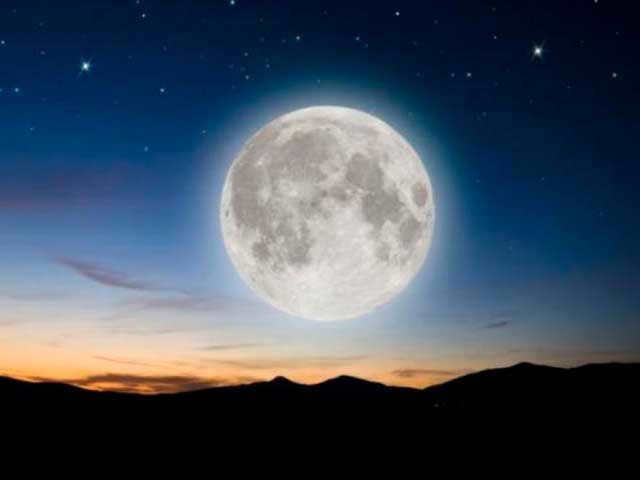
Regarding the internal forces, there are numerous influences during this period. However, the issue lies in the fact that many individuals waste their potential on trivial arguments, resolving relationship matters, and so on. It is not advisable to do the following during the full moon:
- address serious concerns;
- engage in important negotiations;
- participate in large-scale events.
On this occasion, individuals experience a special attraction towards the opposite sex. It is essential not to succumb to temptation, as it may lead to significant regret. It is better to spend time on activities such as meditation, watching a lighthearted film, or listening to pleasant music.
How the third phase of the moon impacts an individual
When the moon is in its third phase, which lasts from 15 to 22 days, it has a rather negative effect on a person: their mood deteriorates and their physical strength decreases. It is not advisable to initiate new tasks or make future plans during this period. Instead, it is crucial to concentrate on:
If you have any short-term projects, they should yield significant outcomes during this phase.
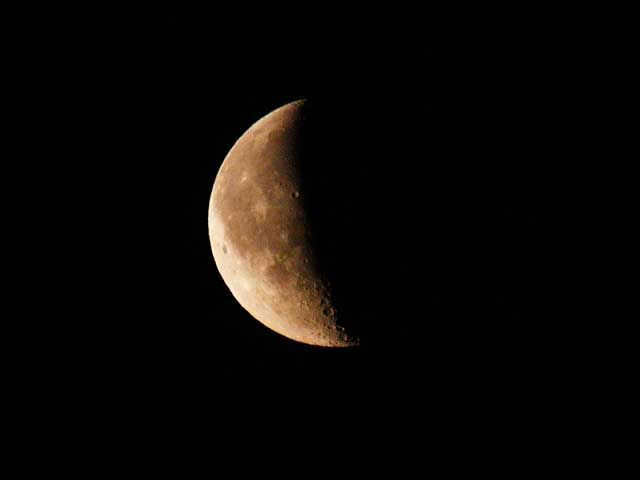
The waning moon is the third phase in the lunar cycle.
During this period, chronic illnesses may worsen. If you are feeling unwell, it is important not to ignore these symptoms and take the necessary measures as soon as possible. It is advisable to avoid scheduling any surgeries or operations during this time. There is a belief that blood clotting is less effective during this phase, although this has not been scientifically proven yet.
Exploring the Impact of the Moon on Human Life
Despite centuries of scientific efforts to fully comprehend the exact influence of the moon on human existence and to provide a definitive answer to this question, no definitive conclusions have been reached thus far.
✔ Indian medical professionals have also undertaken research to explore this phenomenon. Over a span of two years, they closely monitored the occurrence of heart attacks in patients and correlated it with the lunar phase. Surprisingly, their findings revealed that there was a 20% increase in hospital admissions for heart attacks during the new moon compared to the full moon.
✔ A few years ago, researchers from the well-known journal Current Biology conducted a study that provided evidence that the full moon has a negative impact on sleep. On average, adults experience a reduction in sleep duration by 20-25 minutes and a decrease in sleep quality by one-third during this lunar phase. This can be attributed to the significant decrease in melatonin levels that occurs during the full moon.
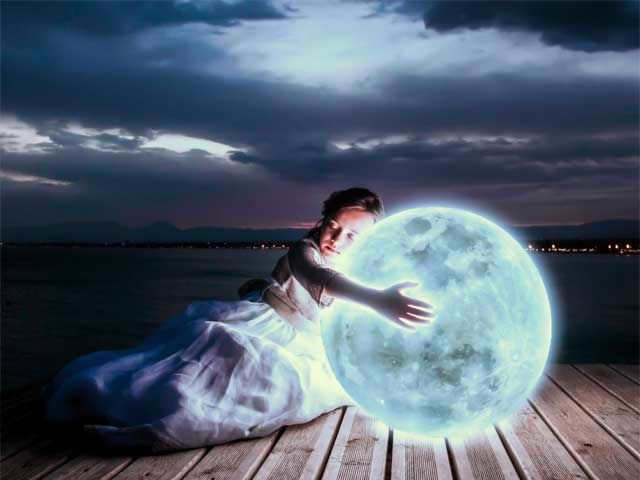
✔ Numerous women hold the belief that their menstrual cycle is influenced by the lunar calendar. However, a group of anthropologists from the United States has successfully disproven this notion. Over the span of three years, they closely observed a tribe of women living deep within the forest, far removed from modern civilization. These women do not use contraceptives and avoid utilizing electrical devices that could potentially impact their biorhythms. After extensive research, no conclusive evidence was found to suggest a connection between the moon and menstruation.
How the Moon influences an individual

How the Moon contributes to our well-being
The majority of scientists concur that the Moon plays a crucial role in maintaining the stability of the Earth’s rotation, which in turn affects our climate. It is thanks to the Moon’s erratic fluctuations in the Earth’s axial tilt that we are spared from potential threats. If the Moon were absent, there would be significant variations in the angle between the equator and the orbit, rendering our planet’s climate uninhabitable.
The Moon played a beneficial role that extended beyond its initial contributions to the emergence of life. One of its notable impacts was the creation of tides, which played a crucial role in aerating the seas. It is even possible that life first originated in the tidal zone, thanks to the Moon’s influence. Additionally, the movement of the Moon across the sky has a significant effect on the life cycles of various organisms. A fascinating example of this is seen in swordtails, which are marine arthropods distantly related to crayfish and crabs. These swordtails only reproduce during specific phases of the Moon.
In the course of time, observations of the Moon have contributed to the advancement of planetary science – as no other planet (except for Earth) has been examined in such intricate detail! However, as our understanding of the Moon has grown, it has raised numerous questions. The biggest enigma lies in the origin of the Moon – various hypotheses have been proposed, yet none of them have been able to account for all the facts. So, what are the key characteristics of our satellite that have posed such challenges for scientists?
Let’s outline the main ones:
- The Moon’s average density is much lower than that of Earth, primarily due to its relatively small core (while Earth’s core makes up around 30% of its mass, the Moon’s core accounts for no more than 2-3%);
- The Moon exhibits a higher concentration of heavy elements (such as thorium, uranium, and titanium);
- However, the composition of oxygen isotopes in the crusts of the Earth and Moon is nearly identical (and it varies significantly between planets and meteorites from different regions of the solar system);
- In addition, the lunar crust is considerably thicker than that of the Earth, suggesting that all of its constituent matter was once in a molten state (while the Earth is believed to have never been completely molten);
- Lastly, the Moon’s orbital plane does not align with the Earth’s equatorial plane.
Among the numerous theories surrounding the formation of our satellite, three hypotheses have gained considerable popularity among scientists. Let’s delve into them.
Origin Theories of the Moon
One hypothesis proposes that the Moon originated from a giant impact between the Earth and a Mars-sized celestial body. This theory is partially supported by the similarity of isotopes found on both the Earth and the Moon. However, it fails to account for the unique characteristics of the Moon’s orbit.
The researchers behind a recent study argue that their hypothesis provides the best explanation based on the available evidence. Nevertheless, there are skeptics who argue that this new theory still fails to address all the peculiarities of the lunar satellite. Thus, the mystery surrounding the origin of the Moon remains unsolved…
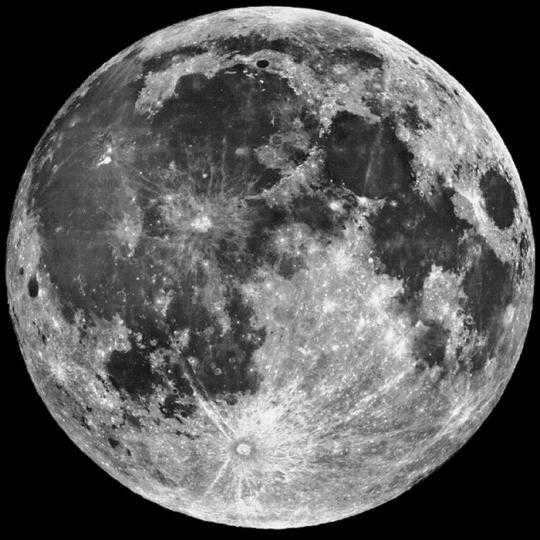
She is an orbiting object.
The Moon captures most of the large celestial bodies that are heading towards it with its gravitational force and redirects their path towards its surface. This serves as a protective shield for the Earth, preventing collisions with massive meteorites.
In my opinion, without the moon, we would have complete darkness at night! Additionally, we would not experience solar eclipses!
If the moon did not exist, the Earth’s gravitational force would be approximately 5% weaker. Consequently, the Earth would not be able to retain as much atmosphere as it currently does. This would result in significantly lower atmospheric pressure and temperature, similar to conditions found at an altitude of 5 or 6 thousand meters above sea level. The Earth would essentially become an ice “block”.
One of the moon’s functions is to serve as a counterbalance.
Additionally, the gravitational force of the moon causes the ocean to move and create tides.
Moreover, the moon provides natural illumination during nighttime.

There are numerous satellites present in the solar system, nevertheless our moon is one of a kind. It exerts a profound impact on Earth, playing a crucial role in maintaining our planet’s stability. This narrative delves into the moon’s influence on our world and its role in shaping its evolution. What would happen to us if we didn’t have the Moon? It seems commonplace to us that the Moon illuminates the night sky, positioned approximately 400,000 kilometers away from Earth. But what if it were situated at a different distance? Closer or farther away. How would that alter our planet?
The Moon is essentially a massive rock suspended in the sky. However, it has the power to manipulate vast amounts of water on Earth. Each day on the western coast of Scotland, a tremendous tidal movement occurs. Approximately 70 million tons of seawater surge in during high tide and recede during low tide. This is the extraordinary effect of the moon.

If the Earth experienced an increase in gravity, it would result in a significant tidal bubble and widespread flooding of islands and cities across the planet. This catastrophic event can be attributed to the moon’s influence, resembling a scene straight out of a disaster movie.
However, let’s take a trip down memory lane. 4.5 billion years ago, during the early stages of the solar system, Earth lacked a moon. Our planet navigated the cosmos independently, enduring constant bombardment from comets and asteroids, akin to a colossal game of space billiards. Nowadays, any remnants of these ancient impacts are nowhere to be found. However, amidst the trillions of celestial debris hurtling through space, some particles managed to come together, forming something far more perilous – the protoplanet Teia. It orbited the Earth and was on a collision course with our planet. The resulting impact was a glancing blow, causing the Earth’s core to fuse with Teia’s core and sending massive amounts of molten rock into Earth’s orbit. As this molten matter cooled and solidified, it gradually formed into a spherical object that we now know as the Moon. Just imagine the awe-inspiring sight – the first ever moonrise over the young Earth. Suddenly, our planet had a companion – a molten planet situated just 22,500 kilometers away. This event brought about a drastic transformation for Earth.
The Earth was shattered and turned inside out when it collided with Theia, resulting in a completely transformed chemical composition. The release of metals like iron from the core and gases like methane, carbon monoxide, and hydrogen into the atmosphere had a profound impact on our planet. These gases played a crucial role in the emergence of life. The collision that formed the Moon created the perfect conditions for life to develop, but it didn’t happen immediately. It took 700 million years for the simplest single-celled organisms to populate the Earth. Once again, the Moon played a key role in this process. As the Earth cooled down, water vapor condensed and formed oceans, thanks to the tidal influence of the Moon.
One of the most recent hypotheses regarding the origin of life has placed significant emphasis on this particular fact. Researchers hypothesize that the tidal movement played a crucial role in the development of life on Earth. Let’s delve into the details of how this process unfolded. By combining the substances found in the early oceans with water, specific conditions were created within the tidal zone. Subsequently, the water would evaporate, causing the rocks to dry out during low tide. However, when high tide arrived, the water would return and submerge the rocks once again. Additionally, ultraviolet irradiation would occur, leading to the transformation of various chemicals. It is within this environment of alternating wet and dry conditions induced by the tides that something extraordinary began to emerge. Upon closer examination at the molecular level, it becomes apparent that two components of RNA (ribonucleic acid) were present. Surprisingly, these complex molecules originated from the simple substances present in this unique setting. RNA, a fundamental building block of living cells, may have initially arisen as a result of the tidal forces driven by the moon’s movement. The tidal zones can be thought of as chemical laboratories, where the building blocks of RNA emerged within one of the bays. As RNA is essential for life, the emergence of the first living organisms in the oceans set the wheels of evolution in motion.
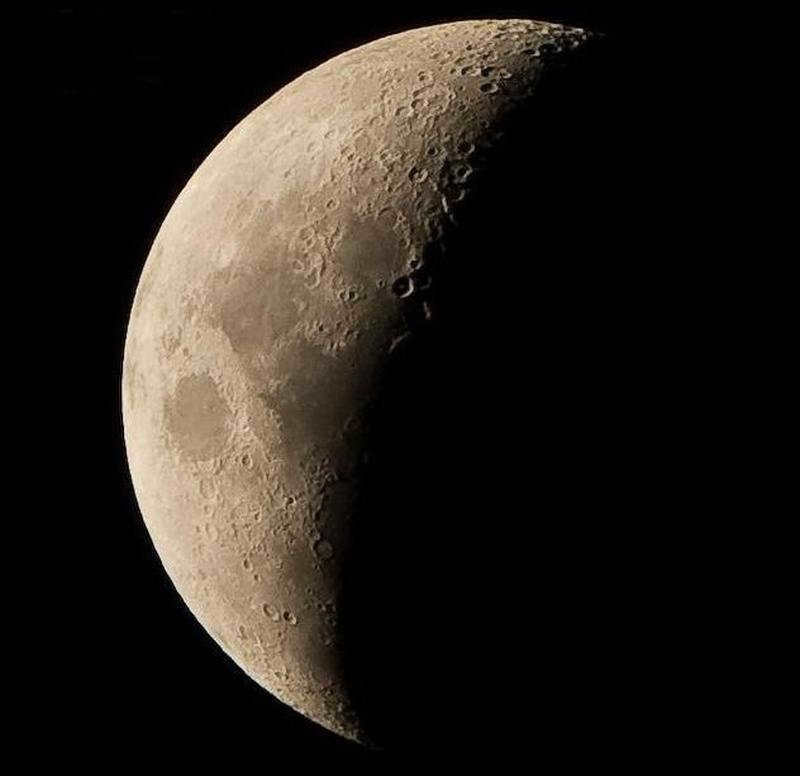
After the invention of the telescope by Galileo Galilei in 1609, humanity was finally able to observe the Moon in great detail. Since then, the Moon has become the most extensively studied celestial body and was even the first to be explored by humans.
What exactly is the Moon?
First and foremost, let us address the question of what our satellite truly is. The answer may come as a surprise: despite being commonly referred to as a satellite, the Moon is technically a fully-fledged planet, just like Earth. It boasts a considerable size, measuring 3,476 kilometers in diameter at the equator, and possesses a mass of 7.347×10^22 kilograms. In fact, the Moon is only slightly smaller than Mercury, which happens to be the smallest planet in our Solar System. These characteristics allow the Moon to actively participate in the gravitational system shared with Earth.
Below is a diagram illustrating the connection between Earth and the Moon:
There is another similar duo in our Solar System, which is Pluto and Charon. This pair is also well-known. Despite the fact that the mass of Charon is only a little over 1/100th of the Earth’s mass, it doesn’t orbit the Earth directly. Instead, the Earth and the Moon share a common center of mass. In addition, the Moon’s close proximity to Earth leads to an intriguing phenomenon known as tidal entrapment. As a result of this, the Moon always presents the same face to the Earth.
Additionally, when observing the Moon from within, it appears to be structured like a fully-developed planet with distinct layers including a solid outer crust, a semi-fluid mantle, and even a central core. In fact, in the ancient past, the Moon was host to active volcanoes. However, all evidence of this fascinating landscape has been erased over the course of the Moon’s extensive 4.5 billion-year history. Countless meteorites and asteroids, weighing millions of tons, have bombarded the lunar surface, causing significant damage and leaving behind countless craters. Some of these impacts were so powerful that they penetrated through the Moon’s crust, reaching the underlying mantle. These impact sites have formed what we now know as lunar seas, dark regions on the Moon that are easily visible from Earth. Interestingly, these lunar seas are only found on the side of the Moon that is visible to us. The reason behind this intriguing phenomenon will be explored in more detail.
Out of all the celestial bodies in the universe, the Moon has the greatest influence on Earth – second only to the Sun. The most noticeable effect of the Moon’s influence is the regular rise in water levels in the world’s oceans, known as lunar tides. However, this is not the Moon’s most powerful impact on our planet. As the Moon gradually moves farther away from Earth, it causes a deceleration in the planet’s rotation, resulting in the lengthening of the solar day from its original 5 hours to the current 24 hours. Additionally, the Moon acts as a natural shield, preventing hundreds of meteorites and asteroids from reaching Earth by intercepting them in their path.
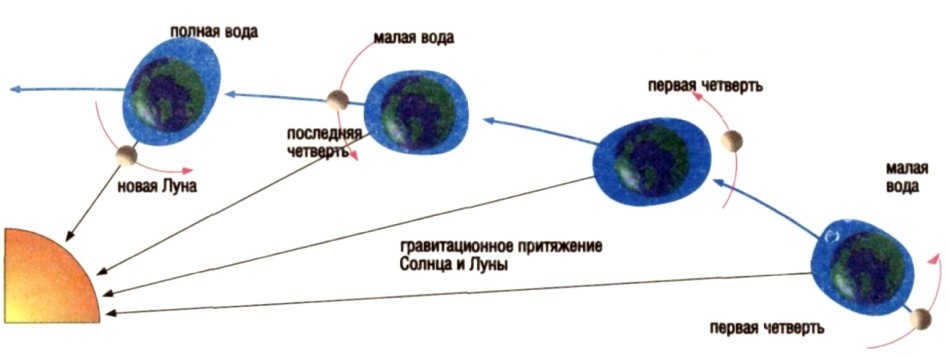
Exploring the phenomena of tides
The Moon has always captivated the attention of astronomers, both amateurs and professionals. Despite advancements in technology that have allowed us to measure the distance to the Moon with great precision and bring back soil samples, there are still unexplained lunar anomalies waiting to be discovered. These anomalies include mysterious flashes and auroras on the Moon’s surface. It seems that our satellite holds many secrets that are yet to be unveiled. Join us on a journey to unravel the mysteries of the Moon!
Unique Characteristics of the Moon
The Moon has been the subject of scientific study for over 2200 years. The ancient Greeks meticulously described its movement in the Earth’s sky, its phases, and its distance from our planet. Today, spacecraft continue to investigate the Moon’s internal structure and history. Thanks to the dedicated work of philosophers, physicists, and mathematicians throughout the centuries, we now have precise data about the appearance and motion of our Moon, as well as insights into its origins and evolution. This wealth of information can be categorized into various interconnected aspects.
The Moon is a celestial body filled with intricate and fascinating features.
The Unique Orbital Characteristics of the Moon
An animated visualization showcasing the Moon’s vibrations in April 2007.
The Moon possesses specific orbital characteristics that are not only of interest to astronomers and astronauts, but also highly valued by photographers. One such phenomenon is the super Moon, when the Moon reaches its maximum size during the full moon phase. This occurs when the Moon is at perigee, its closest point to Earth. Here are the primary parameters of our celestial satellite:
- The Moon’s orbit is elliptical, with an eccentricity of approximately 0.049, indicating a deviation from a perfect circle. Due to the orbital fluctuations, the minimum distance between the satellite and Earth (perigee) measures 362 thousand kilometers, while the maximum distance (apogee) is 405 thousand kilometers.
- The common center of mass for both the Earth and the Moon is situated 4.5 thousand kilometers away from the Earth’s center.
- The lunar month, which is the time it takes for the Moon to complete one orbit around the Earth, is 27.3 days. However, it takes an additional 2.2 days for the Moon to complete a full revolution around the Earth and go through all of its lunar phases. This is because during the time it takes for the Moon to orbit around the Earth, the Earth also moves a thirteenth of its orbit around the Sun!
- The Moon is in a tidal lock with the Earth, meaning it rotates on its axis at the same speed as it orbits around the Earth. As a result, the same side of the Moon is always facing the Earth. This is a common characteristic of satellites that are in close proximity to their planet.
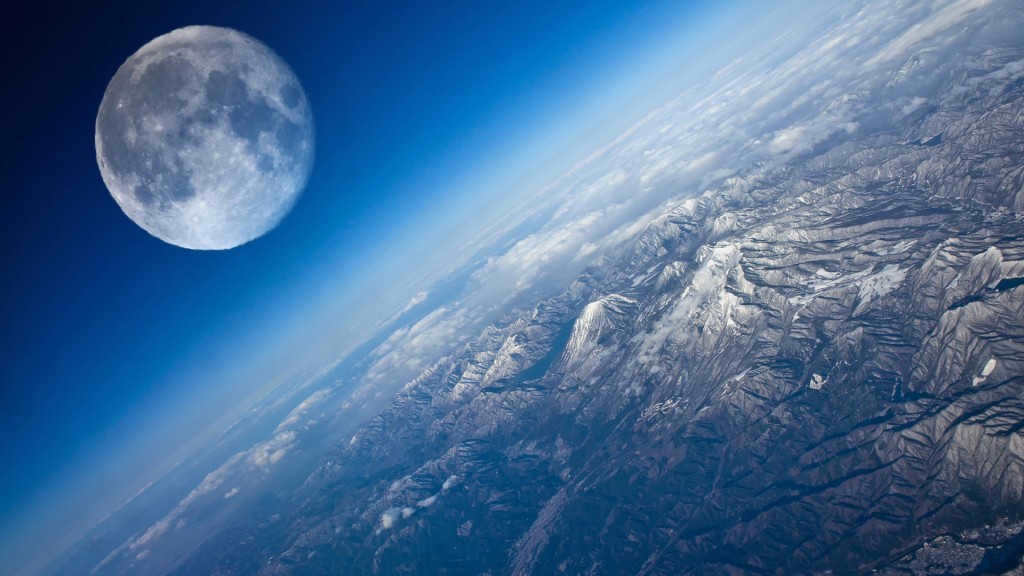

Observing the Moon from the upper layers of the Earth’s atmosphere allows for an optically enlarged image of our celestial neighbor.
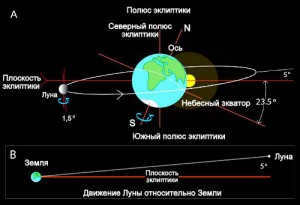
The Moon’s orbit in relation to the Earth is described in detail.
Physical characteristics of the Moon and its makeup
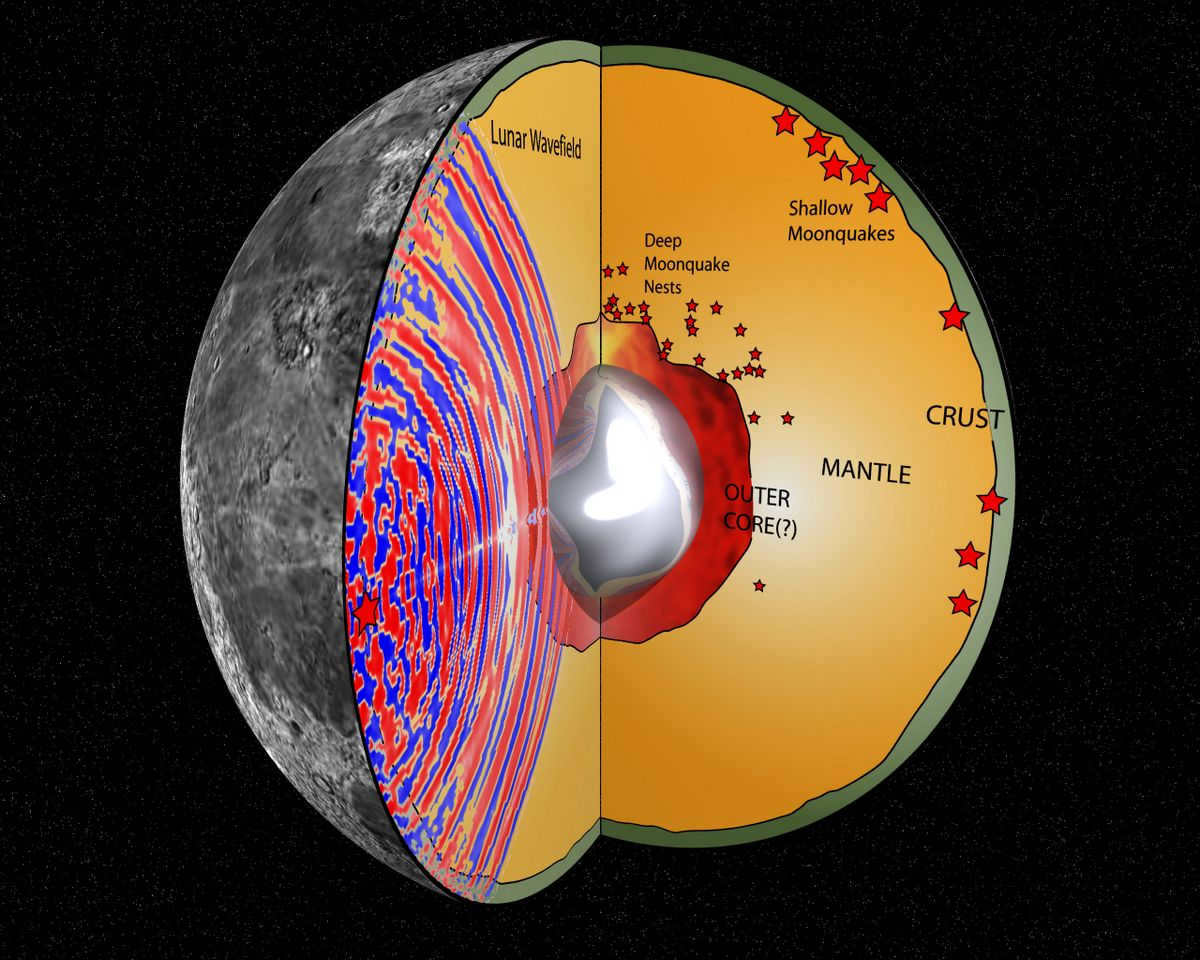

When it comes to complexity, the Moon’s interior is just as intricate as that of the Earth
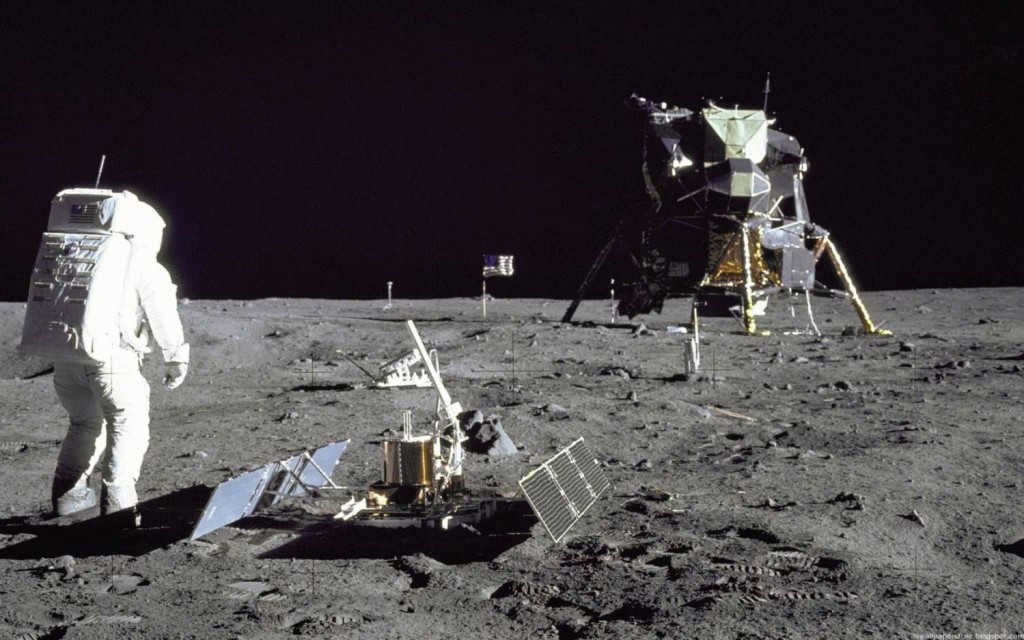
There were several reasons for the distortions of colors and landforms in the reflections on the visors of the spacesuits that were attempted to be replicated. One of these reasons was the use of gold plating on the glass, which serves as a protection against ultraviolet radiation. Moreover, Soviet cosmonauts who witnessed the live broadcast of the astronauts’ landing also confirmed the authenticity of the events. It is difficult to deceive an expert in their own field.
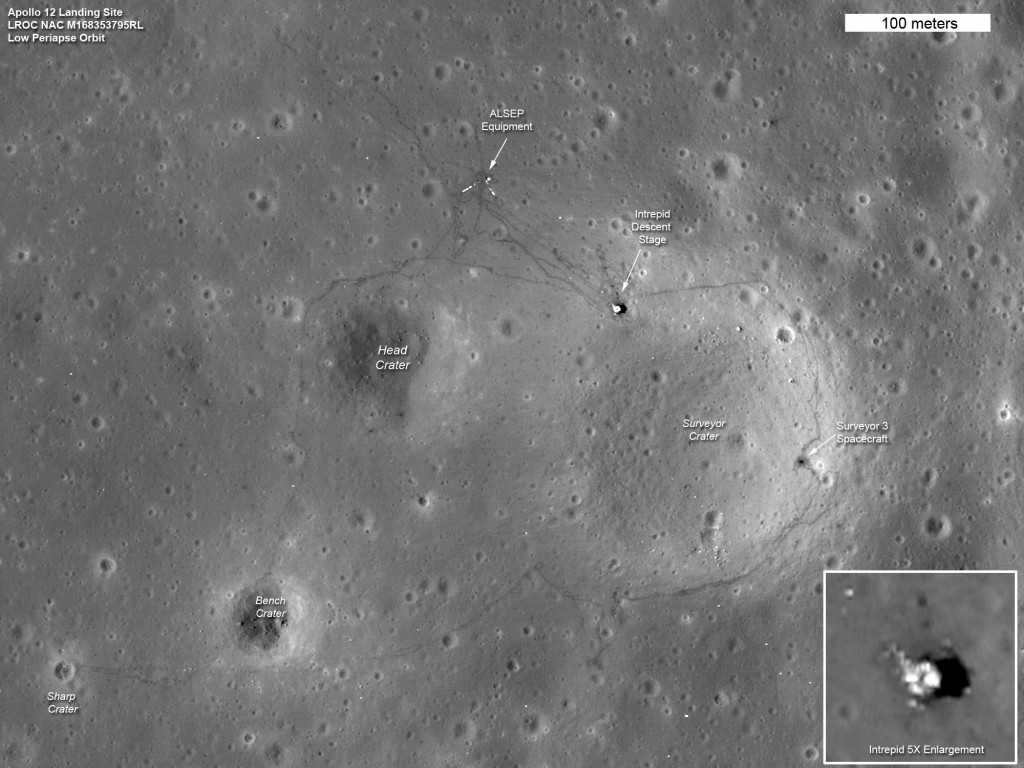
The LRO has captured an image of the Apollo 12 landing site, which can be viewed in full size.
As countries like China and private companies become more involved in exploring the moon, new data is being collected on a daily basis. We have gathered the basic parameters of our satellite:
- The surface area of the Moon is approximately 37.9×10 6 square kilometers, which is equivalent to about 0.07% of Earth’s total surface area. Interestingly, this is only 20% larger than the combined area of all populated regions on our planet!
- The Moon has an average density of 3.4 g/cm 3 , which is about 40% less dense than Earth. This is mainly due to the fact that the Moon lacks many heavy elements, such as iron, that are abundant on our planet. Additionally, approximately 2% of the Moon’s mass is made up of regolith, a fine crumb of rock that is formed through cosmic erosion and meteorite impacts. The density of regolith is lower than that of ordinary rock. In certain areas, the thickness of regolith can reach tens of meters!
- It is common knowledge that the Moon is significantly smaller in size compared to the Earth, which consequently affects its gravitational pull. The acceleration due to gravity on the Moon is only 1.63 m/s2, which is a mere 16.5 percent of the Earth’s gravitational force. Despite the fact that the astronauts’ spacesuits weighed approximately 35.4 kilograms, almost as heavy as a knight’s armor, their jumps on the Moon reached astonishing heights. However, they had to exercise caution as falling in the vacuum of space posed significant risks. You can watch a video below showcasing the astronauts’ jumps during a live broadcast.
- Approximately 17% of the Moon’s surface is covered by lunar seas, primarily on the visible side. These seas are the result of intense meteorite impacts that have fractured and displaced the Moon’s crust. In these areas, there is only a thin layer of solidified lava, known as basalt, separating the surface from the Moon’s mantle. Due to the higher concentration of solid materials towards the center of celestial bodies, the lunar seas contain a higher proportion of metals compared to other regions of the Moon.
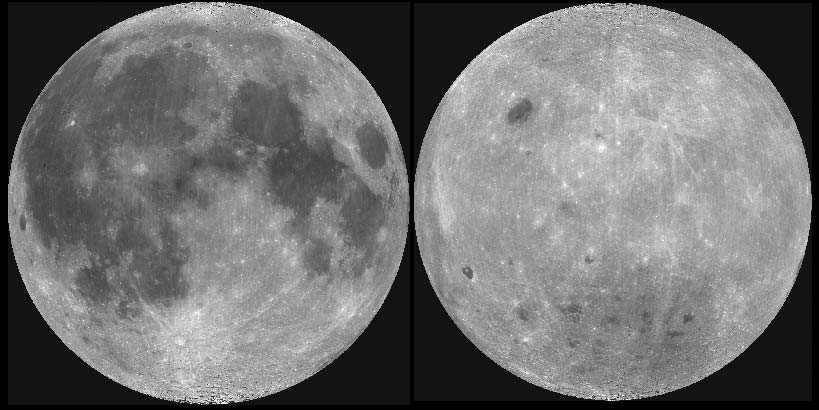
- In addition to craters, mountains, and seas, the Moon also contains caves and fissures, which are remnants of a time when the Moon’s interior was as hot as Earth’s and volcanoes were active. These caves often house water ice, similar to the craters at the poles, making them potential locations for future lunar bases.
- The Moon’s true surface color is actually very dark, closer to black. However, there are various colors present throughout the Moon, ranging from turquoise blue to almost orange. The light gray shade that we see from Earth and in images is a result of the Moon being highly illuminated by the Sun. Due to its dark color, the Moon only reflects about 12% of the sunlight that reaches it. If the Moon were lighter in color, it would appear as bright as daylight during full moons.
What is the process of Moon formation?
The formation of the Moon and its geological evolution poses a significant challenge for scientists. Due to the absence of a protective atmosphere and the constant exposure to cosmic rays, the Moon’s surface experiences extreme temperature fluctuations. With daytime temperatures reaching a scorching 105° C and dropping to a bone-chilling -150° C at night, the harsh conditions on the satellite greatly impact the composition of its minerals. As a result, the Moon’s minerals undergo profound transformations over time. Nevertheless, recent discoveries have shed some light on this complex process.
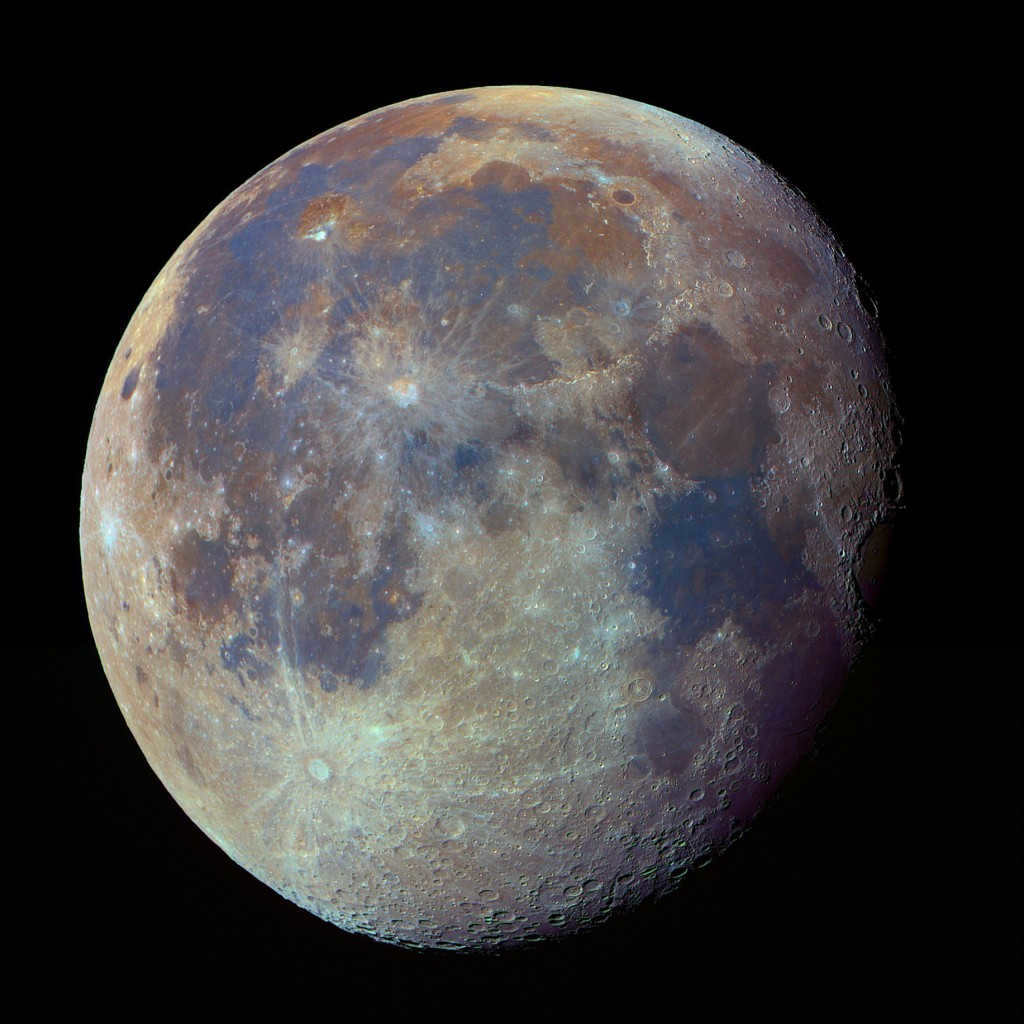
The Moon’s actual hues (with increased saturation)
Scientists now theorize that the Moon originated from a colossal collision between Earth and Theia, a massive protoplanet, that occurred billions of years in the past when our planet was entirely molten. The part of Theia that collided with Earth (which was about the size of Mars) merged with our planet, while its core and a portion of Earth’s surface material were propelled by momentum into orbit, where they eventually formed the Moon.
This demonstrates the previously mentioned lack of iron and other metals on the Moon. When Teia extracted a piece of Earth’s material, the majority of our planet’s heavy elements were drawn towards the core by gravity. This impact influenced Earth’s subsequent evolution, causing it to spin at a faster rate and tilting its axis of rotation, resulting in the occurrence of seasons.
Additionally, the Moon went through a typical planetary development process, resulting in the formation of an iron core, mantle, crust, lithospheric plates, and even its own atmosphere. However, due to its low mass and lack of heavy elements, the Moon’s interior quickly cooled, causing its atmosphere to vaporize from the high temperatures and absence of a magnetic field. Nevertheless, some internal processes still occur, including lunar tremors caused by movements in the Moon’s lithosphere. These tremors pose a significant threat to future Moon colonizers, as they can reach a magnitude of 5.5 on the Richter scale and have a longer duration compared to those on Earth. Unlike the Earth, the Moon lacks an ocean capable of absorbing the seismic energy generated by its interior movements.
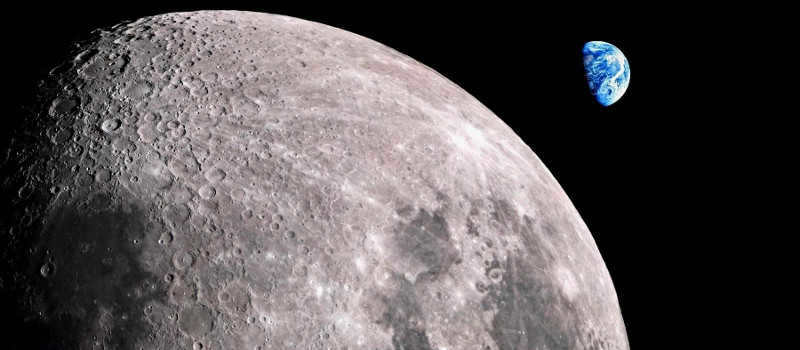
The primary chemical components present on the Moon consist of silicon, aluminum, calcium, and magnesium. The minerals that compose these elements bear a resemblance to those found on Earth and can even be located on our own planet. Nevertheless, the primary disparity between the Moon’s minerals lies in their lack of exposure to water and oxygen generated by living organisms, as well as the elevated concentration of impurities from meteorites and traces of cosmic radiation exposure. The Earth’s ozone layer formed a considerable duration ago, and the atmosphere incinerates the majority of the mass of descending meteorites, permitting water and gases to gradually but surely alter the appearance of our planet.
After Mars, the Moon is the next celestial body that is being prioritized for human colonization. The Moon has already undergone some development, with both the USSR and the USA leaving their marks on the satellite. Additionally, there are orbiting radio telescopes positioned on the far side of the Moon, shielded from Earth’s interference. However, what lies ahead for our satellite?
One significant process that has been mentioned in previous discussions is the Moon’s gradual retreat as a result of tidal acceleration. This retreat happens at a slow pace, with the Moon moving away from Earth by only 0.5 centimeters per year. However, the implications of this process are quite significant. As the Moon moves further from Earth, it also slows down its own rotation. Eventually, there may be a point in time when a day on Earth will match the duration of a lunar month, which is approximately 29-30 days.
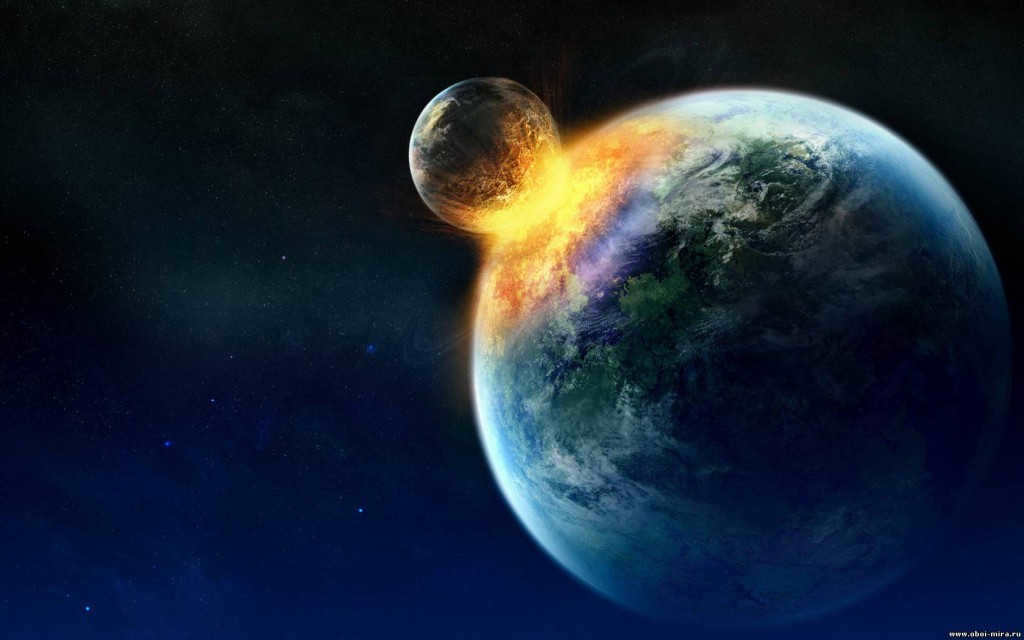

The artist’s view of the Moon and Earth colliding
Nevertheless, there is a limit to the removal of the Moon. Once this limit is reached, the Moon will start to approach the Earth in a cyclical manner, and at a much faster pace than it was moving away. However, a complete collision with the Earth will not be possible. At a distance of 12-20 thousand kilometers from the Earth, the Moon enters its Roche limit – the gravitational threshold at which the satellite of any planet can maintain its solid form. As a result, the Moon will be torn apart into countless small fragments when it gets closer. Some of these fragments will fall to the Earth, causing a bombardment that is thousands of times more powerful than a nuclear explosion, while the rest will form a ring around the planet similar to Saturn’s rings. However, this ring will not be as bright as Saturn’s rings since the rings of gas giants are composed of ice, which is much brighter than the dark rocks of the Moon. Therefore, the Earth’s ring may not always be visible in the sky. The presence of the Earth’s ring will pose a challenge for future astronomers, assuming, of course, that there are still people left on the planet at that time.
Moon Colonization: A New Frontier
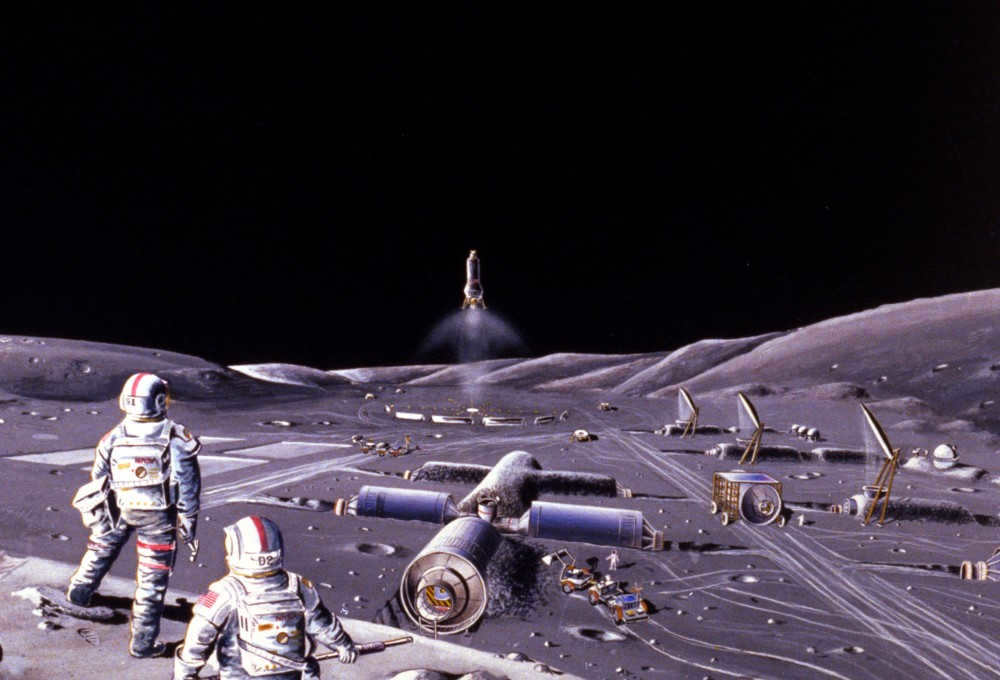
An artist’s conception of a lunar base
The Moon presents itself as an ideal location for a spacecraft takeoff point. With no atmosphere and a gravity that is only 2.38 km/s compared to Earth’s 11.2 km/s, launching becomes significantly easier. Additionally, the Moon’s mineral deposits can be utilized to reduce the amount of fuel needed, which is typically a major burden in space exploration. By establishing rocket fuel production on the Moon, it would become feasible to launch large and complex spacecraft that are assembled using components transported from Earth. The assembly process on the Moon would be much simpler than in Earth’s orbit and also more reliable.
With the current advancements in technology, it is now possible to partially, if not fully, realize the project of colonizing the Moon. However, it is important to acknowledge that any progress made in this direction comes with its fair share of risks. The investment of a substantial amount of money will be necessary to conduct research for the required resources, as well as to develop, deliver, and test modules for future lunar bases. Furthermore, the estimated cost of launching just the initial elements alone has the potential to bankrupt even a superpower!
Therefore, the colonization of the Moon is not solely the responsibility of scientists and engineers, but rather a collective effort of people from all around the world. It is through this unity of humanity that the true strength of our planet lies.
The Moon is a celestial body that orbits around the Earth. It is the Earth’s only natural satellite, as the two planets closest to the sun, Mercury and Venus, do not have any satellites of their own. In the Earth’s sky, the Moon is the second brightest object after the sun. Additionally, it is the fifth largest natural satellite of any planet in the solar system. The average distance between the centers of the Earth and the Moon is approximately 384,467 km, which is equivalent to about 0.00257 astronomical units or roughly 30 times the diameter of the Earth.
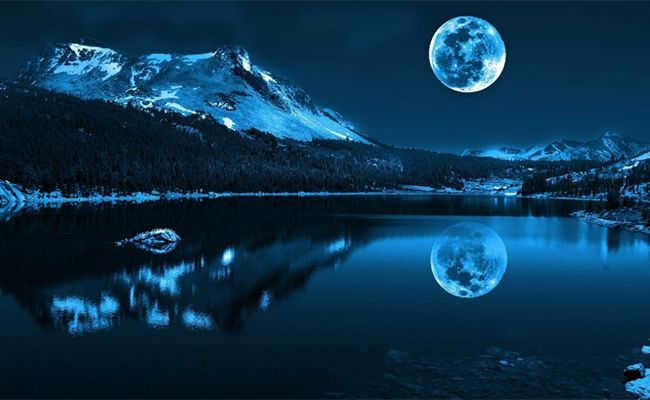
Ancient thinkers were fascinated by the Moon long before modern astronomy emerged, giving rise to legends and stories that glorified this celestial body. Even back then, observations were made about the various behaviors of the Moon and its impact on Earth. It was believed to control certain aspects of human and animal behavior, as well as have an influence on magical rituals, as understood by the ancient scientists. However, the Moon’s influence was not solely viewed through the lens of astrology. In ancient times, the connection between the lunar cycle and tides was also recognized. Today, science has advanced significantly in understanding the Moon’s impact on our planet.
It is common knowledge that the Earth’s faithful companion, the moon, always presents the same face to us. For a considerable period of time, the dark side of the moon remained uncharted territory. However, thanks to the advancements in space exploration over the past century, this situation has been completely transformed. Today, we have access to highly detailed maps of the entire lunar surface.
In certain locations, the force of the tides is so powerful that it causes the water to retreat from the coastline by several hundred meters, revealing the ocean floor. This phenomenon provides an opportunity for the coastal inhabitants to gather various treasures from the sea. However, the water, with unwavering accuracy, ultimately returns to reclaim its original position.
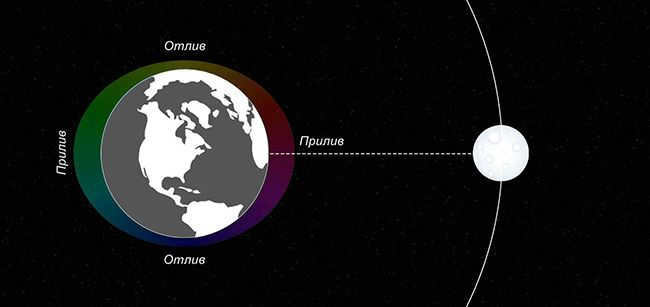

If one lacks knowledge of the tide’s frequency, they may find themselves far from the shoreline and potentially succumb to the advancing water mass. Coastal communities, however, possess a keen understanding of the ebb and flow timetable. This natural phenomenon occurs twice a day and is not limited to just seas and oceans, as all bodies of water are influenced by the Moon. Although less noticeable away from the coast, the water levels still experience subtle fluctuations.
Liquid is the sole natural element that moves in response to the Moon, creating ripples and vibrations. Solid structures such as stones or houses are not subject to lunar attraction due to their rigid composition. On the other hand, the pliable and adaptable water clearly exhibits the lunar mass’s effects.
What is the mechanism behind the Moon’s influence on ocean tides?
The Moon exerts its strongest gravitational pull on the waters of the seas and oceans that are directly facing it.
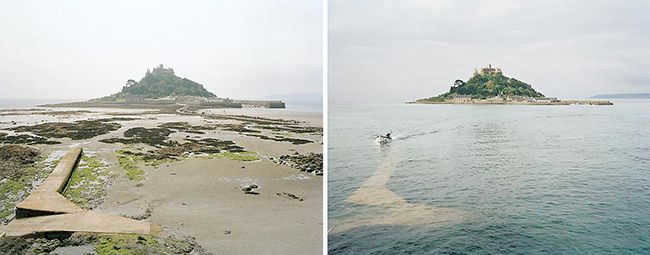

If you take a look at our planet right now, you will notice the Moon’s gravitational pull causing the waters of the oceans to be drawn towards it. As a result, the water column rises and creates two distinct bulges – a larger one on the side facing the Moon and a smaller one on the opposite side.
These tidal bulges perfectly align with the Moon’s movement around the Earth. Since the Earth’s oceans are interconnected, the bulges travel towards and away from the coastlines. As the Moon passes twice through points that are 180 degrees apart, we experience two high tides and two low tides.
The water masses are affected not solely by the Moon, but also by the Sun. The only difference is that the distance between the Earth and the Sun is much greater, so we do not perceive its gravitational influence. However, it is a well-established fact that occasionally the tides become remarkably intense. This phenomenon occurs during the occurrence of a new or full moon, when the Sun’s gravitational pull comes into effect. At this particular moment, all three celestial bodies – the Moon, the Earth, and the Sun – align in a straight line. Consequently, the Earth experiences the combined gravitational forces exerted by both the Moon and the Sun. Naturally, this leads to an increase in the amplitude of the tide’s rise and fall.
People harness the incredible power of the Moon to obtain renewable energy. Tidal hydroelectric power plants are currently being constructed along the coastlines of seas and oceans to generate electricity through the gravitational influence of the Moon. These power plants are renowned for their environmentally friendly nature, as they operate in harmony with natural rhythms and do not contribute to pollution.
Duration of the day
The tidal wave not only causes the specific movement of ocean waters. The influence of the Moon on Earth processes goes beyond that. The resulting tidal wave constantly encounters the continents. The planet’s rotation and its interaction with the satellite create a force that opposes the movement of the Earth’s solid. This leads to a slowdown in the Earth’s rotation around its axis. The duration of one revolution is known as the length of the day. As the planet’s rotation slows down, the length of the day increases. This change occurs gradually, but every few years, the International Earth Rotation Service has to make slight adjustments to the standard against which all clocks are calibrated.
“Guardian” of the Planet
Researchers have made a groundbreaking discovery that highlights the crucial role played by satellites in safeguarding the existence of life on Earth, shielding it from relentless cosmic attacks.
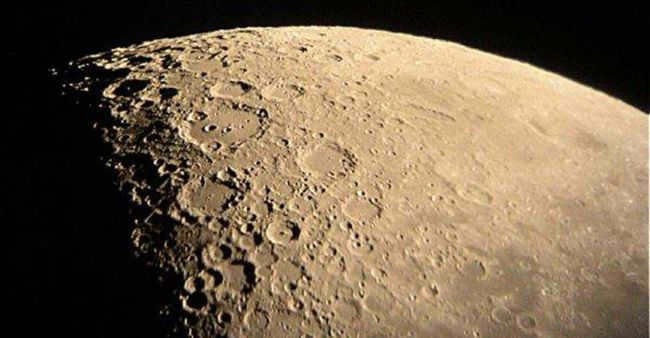
Indeed, the Moon bears the brunt of thousands of asteroids and meteorites. Numerous craters have been discovered on its surface, indicating collisions with celestial bodies larger than 350 kilometers. What would be the outcome if such a “pebble” were to plummet towards Earth?
By way of comparison, allow me to provide an example. Scientists estimate that the celestial body responsible for the demise of the dinosaurs was a mere 5-8 kilometers in size, equivalent to two nuclear bombs dropped on Japan. It has been calculated that in the event of our planet colliding with a celestial body 10 times smaller than the aforementioned, approximately 2 billion people would perish. Hence, the Moon can be dubbed a “gravitational shield” for the planet.
The impact of the moon on an individual
The lunar cycle also has an effect on human sleep patterns. During a full moon, people often experience difficulties sleeping, leading to increased energy, stress, and vulnerability. Interestingly, women tend to be more affected by the full moon than men.
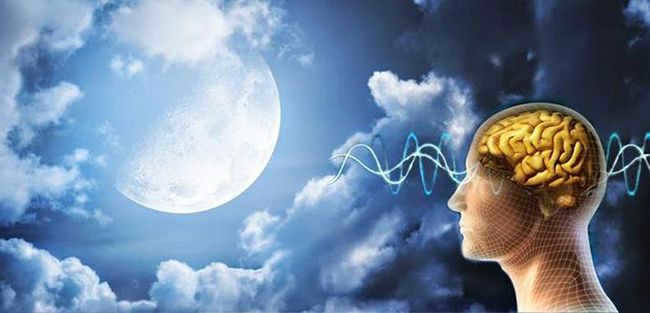

During the full phase of the Moon, people often engage in impulsive actions due to an excess of energy, which can lead to accidents and crimes resulting from frequent stress. It is advisable to avoid resolving conflicts during this period.
In terms of health, illnesses tend to worsen during the full moon, and any pain is felt more intensely. The blood becomes less dense, resulting in poor clotting.
During the full moon, many people experience excessive fatigue and pessimism. Some even lose interest in life temporarily.
Astrologers recommend reducing physical exertion during this time and consuming plenty of fluids, dairy products, vegetables, and fruits.
The period of the waxing Moon is widely considered to be the most optimal time for pursuing different ventures. During this phase, individuals experience a surge in strength and energy, allowing them to handle demanding tasks effortlessly. Moreover, their well-being tends to be stable and exceptional. The metabolism becomes more efficient, resulting in increased flexibility and vitality. Astrologers highly recommend taking care of oneself during this period by undergoing cosmetic treatments, consuming essential vitamins, and engaging in other self-care practices.
The influence of the moon on fish catch
It should come as no surprise that seasoned anglers hold a devout belief that the success of their fishing endeavors is influenced by the celestial luminary. This is not a work of fiction or a mere myth, but rather a well-documented fact that has been proven time and time again through practical experience.


The activity of fish and their feeding patterns directly depend on the phase of the Moon. This is not just a superstition, as scientists have extensively studied this phenomenon.
The best time for fishing is during the full moon. The Moon is closer to the Earth during this phase, causing stronger water currents. As a result, fish become highly active and move swiftly.
In addition, fish require a source of light, and moonlight is perfect for them. This is another reason why the underwater world comes alive during the full moon. However, during the new moon, light barely penetrates the water column, and fish enter a period of rest.
What impact does the Moon have on the Sun?
Both the Sun and the Moon play crucial roles in shaping life on Earth, but is there any connection between the two? Despite their significance, the Moon’s size is minuscule compared to the Sun, making it incapable of exerting any discernible influence on the Sun.
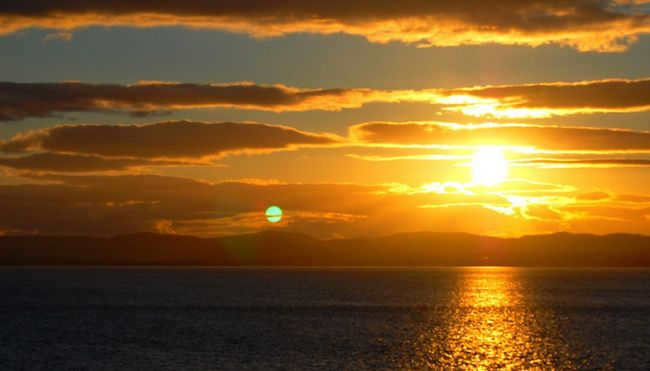
The size of the Sun is 400 times greater than that of the Moon, but it is also located 400 times further away. This is why the two celestial bodies appear to be the same size in the sky.
Additionally, the Sun and the Moon have an interaction with each other through their gravitational fields. As a result, the Moon gradually moves away from the Earth by a few centimeters each year.
What does the future hold?
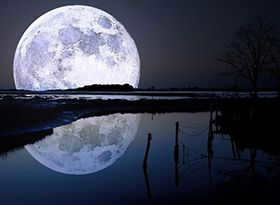
For approximately 4.5 billion years, the Earth and the Moon have been exerting influence on each other. Some scientists believe that both the satellite and the planet formed simultaneously. Throughout this entire period, the Moon has been gradually moving away from the Earth, causing our planet to slow its rotation.
This slowdown will continue until the Earth’s rotation becomes synchronized with the Moon’s movement. At that point, our planet will permanently face the Moon and essentially “freeze” in that position. The gravitational waves created by the Earth have already resulted in a similar effect: the Moon always presents the same face towards the Earth.
Theories explaining the Moon’s origin
In contemporary science, there is a prevailing theory suggesting that the Moon originated from a cloud of dust particles that the early Earth failed to capture.
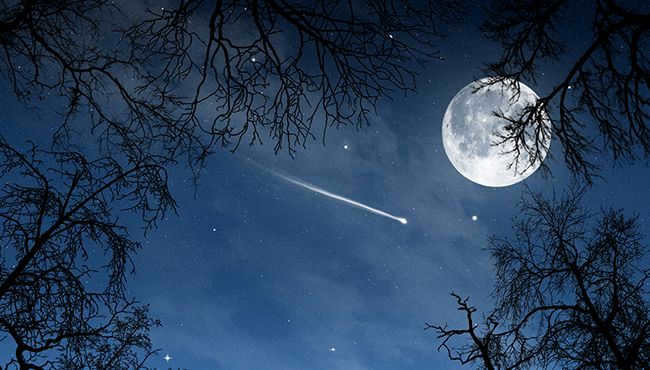
As the composition of the satellite closely resembles that of the Earth, this theory remains unchallenged. However, George Darwin, son of Charles Darwin, believed that the Moon is a fragment of the Earth that broke off due to its rapid rotation in ancient times. It separated near the equator, where the current Pacific Ocean basin is located. However, the problem with this hypothesis is that the basin did not exist at the time of the Moon’s formation, and the Earth’s rotation was not fast enough to cause such detachment. Therefore, this theory was disproven.
There are two other theories regarding the origin of the Moon.
The first theory proposes that the Moon was once a separate planet, but over time it was gravitationally pulled towards the Earth. However, this does not account for the striking similarity in composition between the Moon and Earth. On the other hand, the second theory offers an explanation for this similarity, but it is also highly unlikely. This theory originated in the 1970s in America, with scientists suggesting that the Earth underwent intense heating and vaporization, and the Moon formed from the materials ejected into space. Nevertheless, there is no concrete evidence to support the claim that our planet ever reached such extreme temperatures.
Arguably, the most plausible theory is that the Moon is a fragment of the Earth that broke off during a collision with another celestial body.
What if the moon vanished?
The sudden disappearance of the moon would have a profound effect on our planet. One of the most significant impacts would be on our oceans. Currently, the moon’s gravity attracts water masses, causing bulges and creating tides. Without the moon, these tidal movements would cease to exist.

If the Moon is taken away, all the water that is “pulled” by its gravity will surge onto the land in a tremendous deluge, obliterating everything in its path. The most horrifying tsunamis will pale in comparison to this cataclysmic event. However, that is not the only consequence.
Besides that massive celestial body, our oceans are also governed by the gravitational forces of the sun. Therefore, if the Moon decides to abandon us, we will not be left unattended for long – all authority will be handed over to the Sun, who will become a formidable but not the most amiable ruler.
The Earth’s tilt, without the gravitational forces of the Moon, will become unstable. Temperatures will fluctuate so drastically that this rollercoaster will render many parts of the planet uninhabitable.
"Tidal friction" – a phenomenon that slows down the Earth’s rotation and causes longer days – will cease to exist. As a result, the Earth will actually spin slightly faster in the absence of the Moon, leading to shorter days, which is not favorable news for us.
However, that’s not the only consequence. Without lunar gravity, the Earth’s core might experience some discomfort, resulting in unpleasant occurrences such as widespread volcanic eruptions and earthquakes, which will likely have a negative impact on life on the planet.
The Impact of the Moon on Hair Growth
Our ancestors were aware of the significance of cutting hair during the waxing moon phase in order to promote healthy and robust growth. The lunar month is divided into two parts: waxing and waning. To ascertain the current lunar phase, one simply needs to determine the resemblance of the month to a letter. If it resembles a “C”, the moon is waning, whereas if it resembles an “E” without a tongue in the middle, it is growing. Alternatively, one can consult a lunar haircut calendar for guidance.






